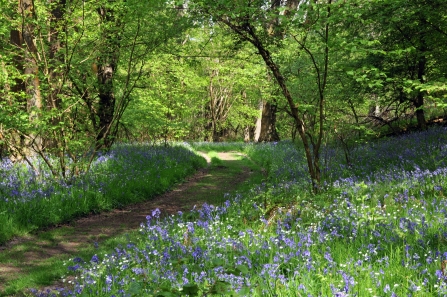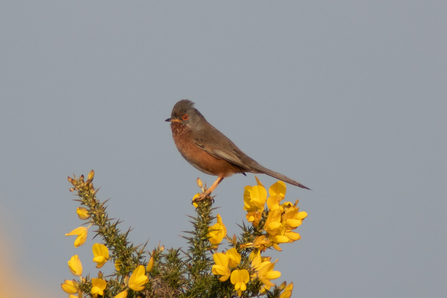
Bowdown Woods by Rob Appleby
Bluebells by Josh Raper - Conservation Media

Bowdown Woods by Rob Appleby
Carpets of bluebells and other woodland flowers fill the woods here in May along with birdsong and trees bursting into leaf. The nature reserve has three areas to explore - Bowdown, Bomb Site and Baynes, all with a different character.
The Bomb Site is so named because it was an ammunition store during and after the Second World War. It is a great example of how nature can thrive and develop on a site vacated by people. Many old, surfaced tracks create a network through the young birch and oak woodland that has colonised the site. Try the short Wildlife Walk from the car park - it's on surfaced tracks and ideal for less mobile visitors.
Bowdown is magical, dense ancient woodland, which has views across the Kennet Valley. The 1-mile Wildlife Walk takes in some damp clay areas on the lower slopes and steep climbs up to higher, drier ground.
Finally, Baynes is the most secretive part of the wood. The dense ancient woodland here has lots of streams and some steep paths. The Wildlife Walk has some steep sections, steps and bridges.
You can explore the reserve and wider countryside around Bowdown Woods on our 6-mile circular walk.

Marsh marigold by Richard Burkmar
Once common, riverside marshes such as this are now scarce because of large-scale drainage for farming but Cholsey Marsh provides a home to a wealth of plants including marsh marigold, insects and birds that depend on the wet reed and sedge beds.
This Thames-side marsh is punctuated with patches of grassland, willow scrub and two large ponds. A variety of birds use the site for breeding and roosting. The ponds attract a range of ducks whilst the reedbed and scrub provide ideal habitat for warblers. The sharp-eyed may pick out a snipe feeding in the marshy grass and Cholsey Marsh is a favoured roosting site for corn buntings and meadow pipits.
As the reserve is on the Thames Path National Trail, it's perfect for exploring as part of a longer walk.
College Lake webcam (https://www.youtube.com/watch?v=JD6mPNDiBdo)
View the live webcam from College Lake
Once a chalk quarry, College Lake is now one of BBOWT's flagship nature reserves. The transformation is a fantastic example of what people passionate about wildlife can bring about through a shared vision and sheer determination.
College Lake is widely regarded as one of the best places in Buckinghamshire for water birds, and with many hides overlooking the lake, this is a great destination for bird watchers or for families, whatever the weather or time of year.
Once you've had a stroll around the lake, pop into the visitor centre for refreshments and a browse in the gift shop.
College Lake has a tramper available for hire, free of charge. Contact the Visitor Centre on 01442 826774 to find out more and make a booking.

Dartford warbler on a gorse bush. Photo taken by Steve Cottrell on Greenham Common
Greenham and Crookham Commons form the largest continuous tract of open heath in Berkshire. It is special for the mix heathers, gorse, grassland and expanses of bare gravels - all easily accessible to visitors.
At this time of year it's important to keep to the paths to avoid disturbing the ground-nesting birds, like nightjar, which breed here. Use the map to find the main paths and areas where you can exercise your dog off the lead.
Heathland habitat is ideal for certain species of birds because of its open nature, with just a few scattered trees and bushes for them to use as singing posts or look out points. It is also relatively warm and dry and has an abundant food source in the form of invertebrates. You may be lucky enough to hear the rich and varied song of a nightingale, or the warbling call of a skylark high in the sky.
Learn more about the transformation of Greenham Common over the last 25 years

Jim Asher
Most of the trees here were felled in the late 1940s, and only a handful of mature oaks remain. Today's 'wildwood' is a mixture of ash, field maple, aspen, hazel and oak along with blackthorn, hawthorn, spindle and a few old hornbeams. The woodland is damp and tussocky with a wide variety of sedges, grasses and rushes.
In spring, the woodland has a scattering of bluebells and contains many plants that thrive in ancient wooded sites, such as wood anemone, primrose and yellow archangel.
In May, look out for moschatel, otherwise known as the 'townhall clock', or 'Good Friday plant'. The small yellow-green flowers are arranged in a fascinating way, at right angles to one another, like the faces of a town clock.

Yellowhammer in hedge by Chris Gomersall/2020VISION
Wells Farm is a working farm run in harmony with wildlife - home to lowland farmland birds including corn bunting, yellowhammer and partridge.
The farm is named after the numerous springs emerging on the valley side. In the valley bottom, a wildflower meadow has been created, and a small tree-lined brook links two ponds, attracting a wide range of wildlife such as frogs, toads, chaffinches, coots and dragonflies.

30 Days Wild is The Wildlife Trusts' annual nature challenge where we ask the nation to do one 'wild' thing a day every day throughout June.